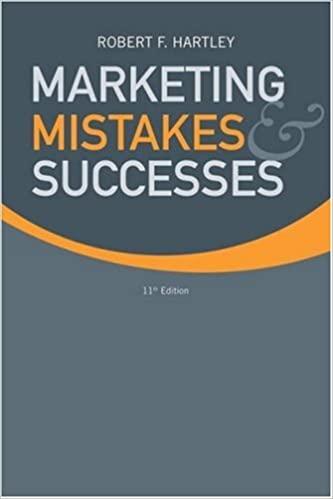Question
Please provide steps for the calculations Sports Depot's is implementing a new strategy to increase sales of tennis balls. The basic idea is to sell
Please provide steps for the calculations
- Sports Depot's is implementing a new strategy to increase sales of tennis balls. The basic idea is to sell tennis balls in large quantities to nonprofit groups, who resell the balls to raise money. For example, a service organization at a local college bought 2,000 tennis balls printed with the college logo. Sports Depot charged $.50 each for the tennis balls, plus a $500 one-time charge for the stamp to print the logo. The service group plans to resell the tennis balls for $2.50 each and contribute the profits to a shelter for the homeless.
A. What is the service organization's average cost for the printed tennis balls it buys from Sports Depot?
B. How many of the printed tennis balls must the service organization sell to cover the $500 fixed printing charge?
- The following terms appeared on an invoice dated May 20, sent by a manufacturer to a retail store: 2/10, net 30. The amount of the invoice was $2,000. Assuming the retailer paid the invoice on May 30 (10 days after the products were delivered), how much should he have paid?
- A large supermarket chain purchases a box of cereal from a food wholesaler. If the supermarket chain uses a markup of 20 percent on its selling price of $2.85, what is the price the supermarket chain paid to the food wholesaler?
- TopKnotch Mfg. Co. has a production cost of $280. It sells its product to a wholesaler for $400. The wholesaler then sells the item to retailers for $500 and the retailers sell the item for $1,000.
A. What is the retailer's markup percentage on selling price?
B. What is the wholesaler's markup percentage on selling price?
C. What is the manufacturer's markup percentage on cost?
- A producer with only one product has total fixed costs of $15,000 per month. In addition, it cost the producer $100 in variable costs to produce each unit of her product (raw materials and direct labor cost). The producer charges her wholesalers $125 per unit.
A. How many units of the product does the producer have to sell each month in order to break even?
B. The producer has set a target profit of $3,500 per month for this product. How many units must be sold to break even and achieve the $3,500
per month?
- Randy Todd, marketing manager for Sporting Products, Inc. (SPI), is thinking about how changes taking place among retailers in his channel might impact his strategy. SPI sells the products it produces through wholesalers and retailers. For example, SPI sells basketballs to Wholesale Supply for $8.00. Wholesale Supply uses a 20 percent markup on selling price, and most of its "sport shop" retailer customers, like Robinson's Sporting Goods, use a 33 percent markup on selling price to arrive at the price they charge final consumers. What is the final selling price Robinson's Sporting Goods charges for an SPI basketball?
- Kashi plans to offer a new line of healthy cereal. The cereal will come in three variations: plain, with raisons, with dried cranberries. The manager has been instructed to set the same price for the three variations even though the production costs differ. Their research has estimated the following numbers for each variation: Plain costs $1.10 to produce with projected sales of 15,000 boxes; With Raisons costs $1.25 to produce with projected sales of 17,000 boxes; and With Cranberries costs $1.45 to produce with projected sales of 12,000 boxes. What will the manager recommend as the selling price if he uses average-cost pricing and a 30% markup on selling price to determine the price per box.
- Wilmington Sports Equipment Inc. started its business producing equipment for tennis. Although it is still known for its top-of-the-line tennis equipment, it has added sporting equipment for almost every sport (golf, football, basketball, soccer, etc.). The R&D team at Wilmington is very excited about a new material for use in the production of tennis rackets. They think that this new material could be a game changer. Wilmington has secured the patent on the new material and developed 2 prototypes to be tested by well-known tennis players. Marketing is currently exploring different price points for the new tennis rackets. They are $449, $399, and $329. Wilmington's current line of tennis rackets range in price from $69 (child's racket) to $299 (professional quality). The new racket will be priced much higher to reflect the higher quality and increased production costs. The fixed costs associated with the new racket is $1,000,000 (much of this is the cost to acquire the patent on the new material). The variable costs are $179 per unit. A. What is the breakeven point at each of the proposed prices? B. Which price would you recommend and why?
Step by Step Solution
There are 3 Steps involved in it
Step: 1

Get Instant Access to Expert-Tailored Solutions
See step-by-step solutions with expert insights and AI powered tools for academic success
Step: 2

Step: 3

Ace Your Homework with AI
Get the answers you need in no time with our AI-driven, step-by-step assistance
Get Started


